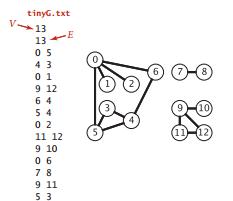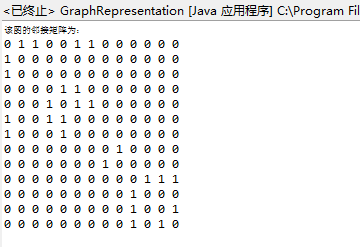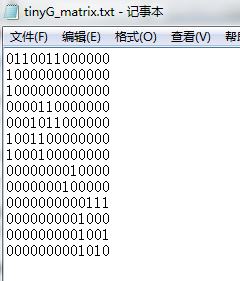1. 图的表示:给定图数据文件(tinyG.txt),计算得到图的邻接矩阵,并把邻接矩阵保存到文件(tinyG_matrix.txt)中。类名:GraphRepresentation。摘自《http://algs4.cs.princeton.edu/home/》P522。
实现代码:
import java.io.*;
public class GraphRepresentation
{
public static void main(String[] args)
{
try
{
FileReader fr=new FileReader("F:\\tinyG.txt");
BufferedReader br=new BufferedReader(fr);
int v,e;
String str="";
str=br.readLine();
v=Integer.parseInt(str);
str="";
str=br.readLine();
v=Integer.parseInt(str);
int[][] g=new int[v][v];
int a,b;
for(a=0;a<v;a++)
for(b=0;b<v;b++)
g[a][b]=0;
str="";
int t1;
while((t1=br.read())!=-1)
{
str = str + (char) t1;
if((char)t1==' ')
{
a = Integer.parseInt(str.trim());
str="";
}
if((char)t1=='\n')
{
b = Integer.parseInt(str.trim());
g[a][b]=1;
g[b][a]=1;
str="";
}
}
br.close();
fr.close();
FileOutputStream fos = new FileOutputStream("f:\\tinyG_matrix.txt");
OutputStreamWriter osw = new OutputStreamWriter(fos, "gb2312");
BufferedWriter bw = new BufferedWriter(osw);
str="";
System.out.println("该图的邻接矩阵为: ");
for(a=0;a<v;a++)
{
for(b=0;b<v;b++)
{
System.out.print(g[a][b]+" ");
str=str+Integer.toString(g[a][b]);
}
System.out.println();
bw.write(str);
bw.newLine();
str="";
}
bw.close();
osw.close();
}
catch (NumberFormatException e)
{
e.printStackTrace();
}
catch (FileNotFoundException e)
{
e.printStackTrace();
}
catch (IOException e)
{
e.printStackTrace();
}
}
}
思路:
先把要读取的文件读入并保存到数组中。由于读取进来的是字符类型,所以在保存进数组前要先进行类型转换。然后根据邻接矩阵的性质把该图的邻接矩阵表示出来。
运行结果:
























 793
793

 被折叠的 条评论
为什么被折叠?
被折叠的 条评论
为什么被折叠?








